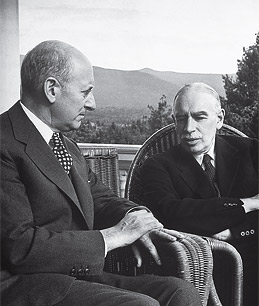
We are all Keynesians now. It’s a phrase that entered public discourse as the headline of a TIME cover story in 1965. Now it’s coming back into fashion. This does not signify that we are all–as was Englishman John Maynard Keynes–Cambridge University economists with lucrative side jobs as investment managers, spectacular art collections, lots of famous friends and Russian-ballerina wives. At least I don’t fit that description. Do you? The resurgence of interest in Keynes also doesn’t represent a full return to 1960s-style Keynesianism–the belief, shared by many economists and politicians in those days, that government could tame the business cycle and guarantee good economic times indefinitely. Instead, what we are seeing now in Washington and other world capitals is fear we might be headed for an economic collapse caused by a collapse of demand caused by a collapse of credit. Confronted with that threat, governments seemingly cannot help turning to the remedy formulated by Keynes during the dark years of the early 1930s: stimulating demand by spending much more than they take in, preferably but not necessarily on useful public works like highways and schools. “I guess everyone is a Keynesian in a foxhole,” jokes Robert Lucas, a University of Chicago economist who won a Nobel Prize in 1995 for theories that criticized Keynes. Keynes’ argument was that when private citizens and businesses panicked and hoarded money, the only way to prevent depression was for government to become the spender of last resort. It’s certainly acting like that now–the U.S. federal budget deficit may top $1 trillion in the current fiscal year, and everybody in Washington seems to be looking for ways to make it bigger. Federal Reserve Chairman Ben Bernanke backs more fiscal stimulus, and President Bush is on board too. Democratic congressional leaders are thrilled by the prospect. Even the Concord Coalition, founded to battle the big deficits of the early 1990s, doesn’t object. Easy money was another remedy proposed by Keynes, although he didn’t think it alone was enough to end a deep slump. Bernanke’s Fed is giving us that too, with short-term interest rates at 1.5% and program after new program to keep cash flowing to banks and businesses. Contrary to popular belief, Keynesian thinking was not a big part of Franklin Roosevelt’s New Deal. Deficit spending and monetary easing were both first put to work in a really big way by the U.S. government in the 1940s–out of wartime necessity, not economic conviction. The economy responded with rapid growth, and after the war, Keynesianism became gospel. Its central tenet, this magazine explained in its 1965 cover story, was that “the modern capitalist economy does not automatically work at top efficiency, but can be raised to that level by the intervention and influence of the government.” A few pages later came the now famous quote from economist Milton Friedman: “We are all Keynesians now.” Friedman later objected that it was taken out of context–all he meant was that everybody used Keynesian language and concepts. But the phrase stuck. It’s often attributed these days to Republican President Richard Nixon, but what Nixon actually said, in 1971, was the less expansive “I am now a Keynesian.”